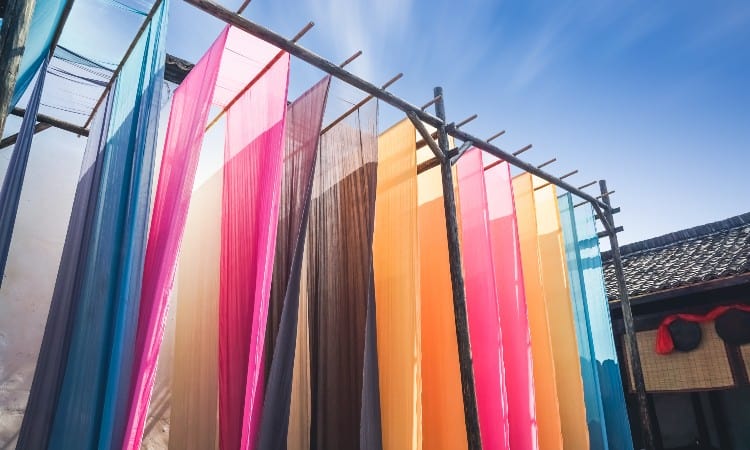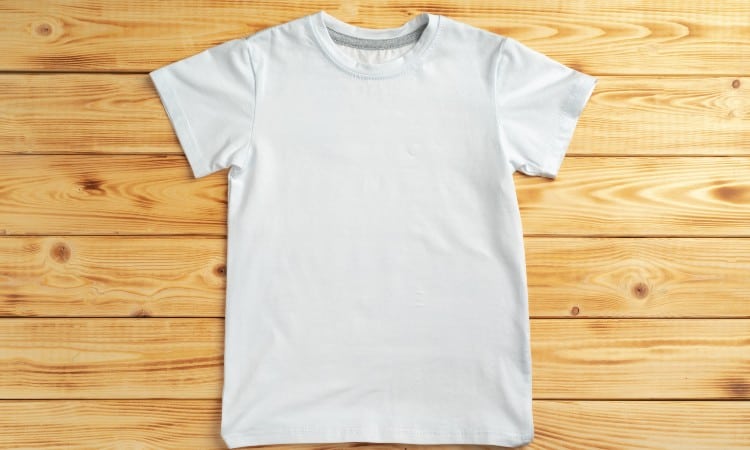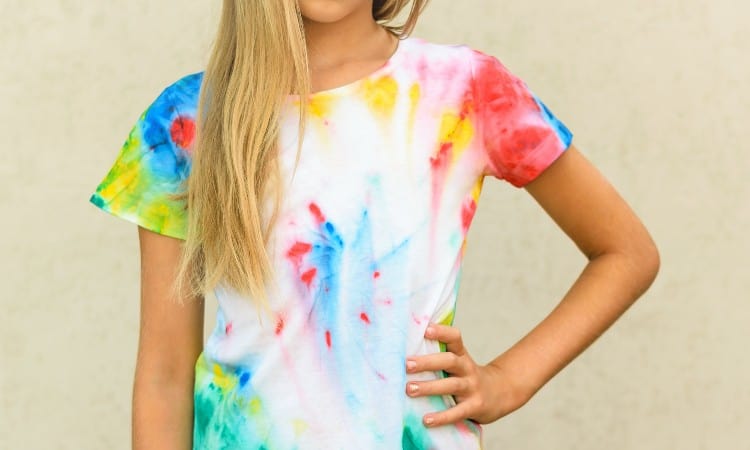Whether you are a cosplay expert fabricating a specialized version of Wonderwoman’s vibrant costume or a DIY artist designing your own clothing, you might be interested in dyeing fabrics to create exactly the right look. Today, a huge percentage of all clothing contains a significant percentage of polyester, a synthetic fabric that does not react to most colorants in the way that natural fibers do. This probably leaves you wondering how to dye polyester.
Polyester must be dyed using disperse dyes and water heated to at least 200℉. The molecules in polyester fibers are hydrophobic and cannot absorb water-soluble dyes. Disperse dyes work only on synthetic materials such as polyester and nylon, and will not color natural fibers.
In this article, you will find out how to dye polyester at home, what coloring products work best on synthetic fabrics, and even how to tie-dye polyester!

Can You Dye 100% Polyester?
You can dye 100% polyester if you use the correct methods and a special colorant designed for synthetic fabrics.
Polyester is a man-made fabric composed of a polymer produced out of petroleum. It’s a plastic specially manufactured into fibers that are then woven or knitted into fabric.
Because polyester is synthetic, its fibers don’t absorb liquids–like water-soluble colorants–in the way that most natural fibers do. This means that polyester is not easy to color like cotton. Instead, polyester requires either heat or chemical treatments to open up its fibers enough to absorb the special disperse dyes used to color synthetics.
The dyeing process most manufacturers use for polyester is pretty intense. Large factories use heavy equipment, including jet dyeing machines, which can continuously soak the cloth at a temperature of 280℉ with a heated colorant mixture.
Other facilities soak the cloth in large vats using a carrier liquid to transfer the disperse dye into the polyester. However, the carrier chemical can make the finished fabric stiff to the touch.

For very fine polyester materials, such as sheers and faux-silks, some factories employ special roller machines that continuously expose the cloth to the heated solution without the high pressure of heated jets.
These complex chemical and mechanical set-ups often take place during the manufacturing process, sometimes while the cloth is still in yarn form and other times after it has been woven or knitted into the material.
The great thing about this complicated process is that polyester never bleeds or fades because the color is heat-set into the material.
After reading all of this, are you wondering why you would want to try dyeing polyester at home?
Well, the fact of the matter is that more than half of all the clothes sold around the world today contain a significant amount of polyester. This means that you’re kind of stuck if you want to color your clothes!
You may also want to learn the process of dyeing synthetics because many sewing and crafting projects require this skill. For example, if you plan to build a cosplay costume, you will almost certainly require some synthetic or plastic components.
The good news is that you can dye polyester at home without all of the heavy-duty machinery used in manufacturing facilities.
What to Consider When Dyeing Polyester Fabric at Home

Before you commit to dyeing polyester at home, you should consider several key factors.
First, you need to know exactly what kind of fabric you’re working with. If you plan to dye an unworked piece of cloth, check the end of the fabric bolt to find out if you are buying 100% polyester or a polyester blend. For a ready-made item, you can find this information on the manufacturer’s label inside the garment.
Why does this matter? Manufacturers often blend polyester with another kind of fiber, such as cotton, to create a softer and more breathable material. You should use a special synthetic colorant only if the material contains more than 35% synthetic fibers.
Other blends, such as polyester and spandex (common in leggings and sportswear), really cannot be dyed at home. Spandex can’t withstand the high temperatures you need to make disperse dyes function.
The style and condition of the item you want to color also make a difference. For example, many ready-made garments have special curves or pleats that are heat-set to hold their shape essentially forever.
Polyester’s durability is one of its great strengths. However, if you heat the polyester intensely to re-dye it at home, you may damage the pleats, curves, folds, or patterns of the original garment.
You also need to figure out if your item can safely get wet. If it requires dry-cleaning, it probably won’t survive the boiling-water dye bath.
You should also inspect your item carefully for any rips, tears, stains, or bleached or faded spots. These will all show through the final coloring. Even if you use a black colorant, a faded spot will show up lighter than the rest of the garment when you are done!
Next, how much do you remember from the elementary school art class when you first learned about the color wheel? You probably used finger paint to mix blue and yellow together to create a sickly shade of green.
Well, dye operates just like that finger paint! If you want to turn a yellow shirt green, don’t color it with green dye. You’ll need to use blue dye.
Finally, your choice of colorant matters, too. Keep reading to find out all about the different kinds of synthetic dyes available on the market today!
Dyeing Polyester With Disperse Dyes
You can think of disperse dyes as incredibly fine powder suspended in a liquid. These tiny pigments do not dissolve in the liquid the way water-soluble or acid-based colorants do. Instead, they depend on heat to open up the fibers of synthetic materials so the pigments in the dye bath can infiltrate into the cloth.
Manufacturers use disperse dyes to color polyester permanently. Fortunately, you can also use these products, on a much smaller scale, at home!
Rit is the most recognizable DIY brand selling disperse dyes today. You can find this brand for sale on Amazon or at most local arts and craft stores. However, do take care to read the label or product description to make sure you purchase disperse dyes and not the water-soluble versions also sold by Rit!
Since you probably don’t have a massive set of factory equipment at home, keep in mind that you will need to take special measures to wash or pre-treat the item before you begin.
You will also need a way to heat the item you want to color. Most people use a sizeable metal pot on a stovetop.
How to Dye Polyester With Rit
Let’s look at a step-by-step guide for how to dye polyester using Rit dyes. First, you should know that regular Rit All-Purpose dye will not work on 100% polyester. However, Rit has a new product, Rit DyeMore, which is a disperse dye.
Like most projects, you need to do a bit of prep work to get your item ready for a dye bath. Inspect the item carefully for any stains and do your best to remove them, as they will mar the finished product.
 Then wash the item with soap, but without fabric softener or any other treatments.
Then wash the item with soap, but without fabric softener or any other treatments.
Use a kitchen scale to weigh the item. One package of Rit DyeMore should color up to 2 pounds of dry cloth, so you will need to know how much the cloth weighs to determine how much dye you need.
As a final prep step, find yourself some gloves and cover up everything around your stove with paper or plastic sheeting if you create any splattering as you work. You don’t want to stain your kitchen counters!
Now you’re ready to get started! You will probably need the biggest metal pot you own since Rit recommends using three gallons of water for every pound of fabric.
- Measure the water in an appropriate amount for the pounds of cloth you plan to color, and include 1 teaspoon of dish detergent.
- Bring the water to a boil. You can use a cooking thermometer if you want to make sure the water is at 200℉.
- Shake up your sealed dye packet, open it, and stir it into the boiling water.
- Add the cloth item carefully into the boiling dye bath. Be sure to stir the pot continuously for the first ten minutes! This ensures that all areas of the item will color smoothly.
- Keep your polyester item in the pot for at least 30 minutes.
- To remove the item from the dye bath, your best bet is probably to carry the whole pot to your kitchen sink. Use tongs or something other than your hands to remove the item and hold it under the sink tap.
- Rinse repeatedly in warm water, and then gradually in cooler water, until you see the water run clear.
- Finally, run the cloth item through a warm wash cycle in your washing machine, and allow it to air dry.
How to Dye Polyester With Dylon
Right off the bat, you should know that Dylon dyes will not work on 100% polyester. However, while Dylon does not sell disperse dyes, the brand does offer a method for coloring polycotton blends that contain less than 50% polyester.
 For this reason, you can safely use Dylon dye on many products, such as cotton blend t-shirts.
For this reason, you can safely use Dylon dye on many products, such as cotton blend t-shirts.
The good news about using Dylon, though, is that the process is much simpler! You don’t need boiling water to heat-set the color since this colorant dissolves in water.
- First, weigh the item you plan to color. Dylon states that one packet of powder should color half a pound of cloth, so purchase the packets accordingly.
- Then wash the item with soap and remove it from the washer when it’s still damp.
- Fill a glass bowl or metal pot with water–use 2 ¼ cups of water for each dye packet. Stir in five tablespoons of table salt for each packet as well.
- Stir in the dye, mixing till dissolved.
- Add the cloth item into the dye bath. Stir gently for fifteen minutes, and then allow to rest for 45 minutes.
- Use gloves to remove the item from the bath over your kitchen sink, and rinse in cool water until the water runs clear.
- Finally, run the finished item through a warm water washing machine cycle and allow it to air dry.
How to Dye Polyester with Acrylic Paint

Acrylic paints work better than most fabric paints or oil-based paints on polyester. If you’re into fabric art, you probably want to know what kind of paint to use for brushing, stamping, or drawing on polyester!
If you plan to paint directly onto the polyester, you will probably need a fabric medium to thin the paint and prevent it from cracking as it dries.
You can also find acrylic paint markers, which work very much like fabric markers and allow you to create detailed work on the surface of the material.
Many artists also use acrylic paint to stamp designs onto polyester cloth, though in this case, you would be wise to test out the fabric medium, as well, to make sure your stamped design doesn’t crack and crumble away over time.
How to Dye Polyester With Food Coloring
You can sort-of tint polyester temporarily with food coloring, but it will wash out at any hint of moisture.
Some artists use a wash of water and vinegar to pre-treat natural materials that will hold food coloring designs. This works especially well on wool and silk, which have proteins in their fibers that can hold onto these colors.
However, the food coloring will not set in polyester. This is because water-soluble colorants cannot soak into polyester fibers, which are hydrophobic and essentially repel water.
If you’re working with a polycotton blend, you may be able to temporarily color or tint it with food coloring, but the color will likely come out in the first wash.
Can Coffee Dye Polyester?

Coffee can give a lovely natural cream, tan, or brown shade to many natural fabrics, but it does not successfully dye polyester.
You can try boiling pure white polyester in a pot of extremely strong black coffee for an hour, and you may achieve a slight shading of brown. However, the color will likely come out in the wash.
Most synthetic fabrics do not accept natural colorings because they don’t do well with food coloring–they can’t absorb water-soluble colorants.
It makes sense when you realize that natural or plant-based colorants pair best with natural fabrics. Synthetic fabrics just don’t merge with natural colorants on a cellular level.
Can You Dye Polyester in the Washing Machine?
It is unlikely that trying to dye 100% polyester in the washing machine will turn out well. All of the disperse dyes currently on the market require heat. This means you can’t use a washing machine to color 100% polyester because even its hottest settings won’t get the water to 200℉, which is necessary to transfer color to polyester.
However, you can use a water-soluble colorant such as Rit All-Purpose or Dylon in the washing machine if your item contains less than 50% polyester. When coloring a polyblend, you probably want to use a dark shade since only the natural fibers in the weave will change colors. Because of this, if you color the cloth red, and only half of the fibers turn red, you will be left with a cloth that looks pink!
Please also note that you will need to run your machine through a couple of wash cycles to clear away any lingering stain before you put a load of laundry in!
Can You Dye Polyester Curtains?

You can use disperse dyes to color polyester curtains, but you may need to take a couple of additional steps to ensure an even, thorough coloring.
First, determine what kind of material the curtains are made of. Even 100% polyester can be woven or knitted into many different kinds of cloth. Many polyester curtains are either sheer patterned panels or thick broadcloth drapes.
Before you start, you should also make sure your kitchen can accommodate dyeing a large item like a curtain. Do you have a metal pot big enough to hold a curtain and the gallons of water necessary for disperse dyes? On top of that, do you have a stovetop large enough to fit this enormous pot?
If you want to color heavy broadcloth drapes, you will need to wash them in a warm-water machine cycle with ½ teaspoon of soda ash and ½ teaspoon of Synthrapol, a special detergent that helps the coloring process, for every pound of dry cloth. This will remove any starch or chemical treatments on the surface of the fabric.
After the special pre-wash, you can follow the steps laid out for dying polyester with Rit DyeMore earlier in this article.
You might want to consider using fabric art to decorate your polyester curtains instead of completely coloring them. For example, you could stamp a fun design on white curtains using acrylic paint.
If your polyester fabrics are sheers, you may have difficulty achieving an even coloring job. This is especially true if the sheers are already patterned, as the pattern will show through the new color and may not look attractive.
You may want custom-dyed curtains for your home. In that case, these steps should help you achieve exactly the style you want! However, you may also want to consider the fact that polyester curtains typically cost very little. You might be better off saving yourself the time and effort and just purchasing new polyester curtains in a color that you like.
Can You Tie-Dye Polyester?

Polyester does not tie-dye as easily as natural fabrics such as cotton knit. You can’t easily use sharpies and rubbing alcohol to spread fun tie-dye patterns over polyester material as you can with cotton. You can tie-dye even 100% polyester fabric if you follow these steps:
- First, prewash the item you want to tie-dye. You don’t need to dry it.
- Next, scrunch up small tufts or handfuls of the damp fabric and secure these bunches of material with a tightly knotted string or a rubber band. These bunches will create the ringed, tie-dye pattern when you are done!
- Now you will need to proceed through the basic disperse dyeing process, including mixing water and disperse powder based on the pounds of dry fabric you plan to color.
- You will need to go through the full stirring and boiling process described in the section on Rit DyeMore as well.
- If you want different sections of your tie-dyed item colored in contrasting shades, only submerge a portion of the item in the dye bath at a time.
- Finally, rinse the finished product repeatedly in warm water.
- Some artists recommend washing the item in a bath of warm water and Synthrapol as an additional last step.
What is the Best Dye for Polyester?
Today, you can easily find disperse dyes made especially for synthetic materials. Not long ago, everyone agreed that coloring polyester outside of a factory was impossible, so you are coming to this project at a great time in the world of fabric design!
Some common brands of DIY disperse dyes include Rit DyeMore, iDye Poly, and KraftKolour.
Conclusion
Are you ready to dig out your largest pot and start boiling that polyester? Hopefully, you feel like an expert on how to use synthetic disperse dyes. You also know all about why water-soluble and natural dyes won’t work on polyester.
What kind of polyester item do you plan to dye? Have you ever attempted to dye something as large as a curtain? Leave a comment below to let us know!
